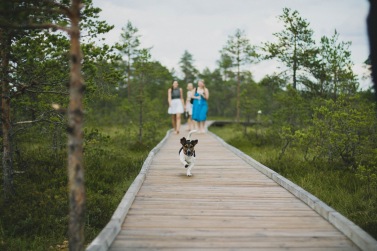 Imagine a plain big patch of grass in front of your house without any sort of guidelines depicting a passage… It would look so incomplete. Walkways not only add a passage to walk through the garden but also add a touch of style to your garden design.
Imagine a plain big patch of grass in front of your house without any sort of guidelines depicting a passage… It would look so incomplete. Walkways not only add a passage to walk through the garden but also add a touch of style to your garden design.
What is a walkway?
A raised path or passageway that connects different sections on a road, in a garden, park or any other space and is used for walking is a walkway. These walkways are also known as sidewalks, pavements, pathways and footway. It may or may not have a boundary.
The walkway that are present along the road are always raised. But when the walkways are used as a part of outdoor architecture, these may or may not be raised depending on factors like the garden design, requirement of the project, weather conditions and so on. These outdoor pathways are used by the pedestrians and cyclists. History has it that the pavements were first seen in the 4th century. The Romans also built these as a part of their outdoor architecture. Walkways were then known as “semitas”.
What role does it play in outdoor architecture?
Walkways play an important role in the modern architecture. These walkways are used as a part of garden design. To move through the garden or parks easily, pathways provide a pre-defined track. There are many other uses of a pathways. These are built along as a part of any construction project solely based on its purpose and requirement. Let’s take a look at it:
1. Transportation:
Pavements are built along the road or in parks to facilitate easy movement of pedestrians. These pathways separate the cyclists’ area and pedestrian walking areas from that of motorised traffic. These are usually in pairs, on either side of the road or according to the need in parks or outdoor spaces.
These pathways are also being seen in personal gardens as architects emphasise on its functional aspect. In a garden, the presence of pavements or walkways makes it easy to walk from one area to another without harming the grass and plants as well as your shoes.
2. Safety:
One of the important function of building a sidewalk with a raised height is to protect the passersby form the moving traffic and avoid accident. In parks, animal sanctuaries and gardens these work as a track for the movement of people, cyclists, people who walk their pets or kids visiting these places.
Presence of walkways makes it easy to take heed of the areas that are accessible and those that are not to be accessed. Many a times, pathways that are present in gardens play the role of boundaries of plant beds.
3. 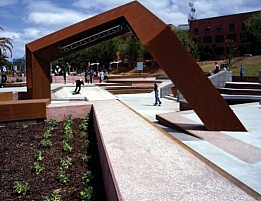 Health:
Health:
Walkways, specially in large outdoor spaces, encourage people to walk or cycle more. The present way of life has a grave effect on the health of an individual. In 2013, the leading cause of death in females was due to coronary heart diseases. Such ailments affect the body due to lack of exercise and poor eating habits. Walking lowers the chances of obesity, cardiovascular diseases and other lifestyle diseases. The presence of pavements and outdoor pathways encourage people to indulge in physical activities such as walking, cycling or exercising thus having a beneficial effect on the health of an individual.
4. Social Usage:
Many-a-times, these sidewalks are used for social purposes like small gatherings, cafes’ sitting layouts, small shops, musicians and son on. In a personal space one can always hold up a garage sale or any other activity.
Based on the function and placement, the outdoor pathways are divided into different types. The various types usually consist of uses of different materials depending on the use of the end-product. For example, if you wish to have garden walkways build in your backyard and kitchen garden then the use of wood or pebbles works best; If the pathway is to be placed in front of the house then people go for concrete walkways or tiles and son on.
With an increase in the environmental awareness, more and more eco-friendly materials are also being put to use for construction purposes. Multi-purpose pathways that are present along the roads are being made of softer materials like asphalt or tarmac.
ProjectLink has a variety of walkway options for you. Let’s take a look at the types of walkways and materials that can be used to make these:
1.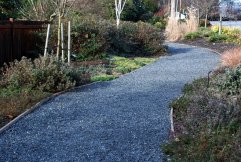 Concrete Pavements:
Concrete Pavements:
The most common medium that is used to build a garden walkway is concrete. These pathways consist of poured concrete ribbons. A cross-lying-strain-relief indentation is present on these concrete walkways at regular intervals.
Usually the distance is about 5 feet but you can personalise the walkway in your garden by the use of design impressions or carving out your initials and year. The use of colors can also be done. You can go ahead and be creative here if you want a garden walkway that looks exclusive. These days concrete tiles are also available. In area theatre susceptible to snow and extreme cold, joints are provided between two blocks of concrete. This give it an expansion space so that the walkway does not develop cracks.
Take a look at what ProjectLink has to offer for Concrete walkways »
2. 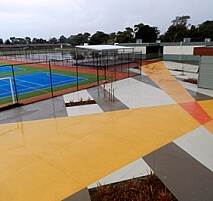 Asphalt and Tarmac Walkways:
Asphalt and Tarmac Walkways:
Tarmacadam or tarmac is material used for road surfacing. It was invented by Edgar Purnell Hooley and first used in 1902. Materials like tar-grounded macadam, modern asphalt concrete and bituminous surface treatments fall under this category.
Tarmac is commonly used on airport ramps as well as runways. When it is spread over any surface, the surface is saved from rutting. This material is gaining importance in the construction industry. Asphalt is known to weatherproof the walkway. Since it is available in colors, you can beautify your garden walkways and the maintenance is low.
Get to know more about the product Asphalt and Tarmac Walkways »
3. 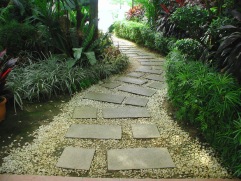 Stone and Pavers
Stone and Pavers
Stones and slabs are another commonly seen materials used for pathways. Installing a pathway lined with stone slabs enhances the appearance of the entire building. Stone slabs are of many varieties. You can pick a polished slab or a natural looking unpolished set of slabs for your outdoor pathways. The texture of the stone varies accordingly.
A more cost-effective option are the pavers. Pavers have been used since long as outdoor surface coverings. These are concrete bricks made by moulding the cement mixture into the shape of blocks or any given design. Interlocking pavers are also present. These form a tessellation like design over the surface that there are placed on. Depending on designs, sizes, colors and functionality, pavers have a large range to choose from for your personal outdoor space.
Check out options for stone and pavers here »
4.  Bricks
Bricks
Using bricks for the garden walkways is a great and cost-effective technique. It increases the aesthetic value of the garden design and the bricks can be laid in any tessellating pattern. When a pathway is made by laying bricks, a mechanical vibrator is used to lock the bricks in place once all the bricks have been laid.
This can be alternately done with the help of tools such as hammers or heavy rolls but using a mechanical vibrator speeds up the process.
Here are some options for your garden walkways »
5. 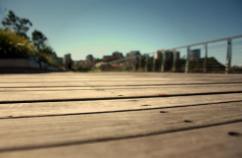 Wood:
Wood:
Wood is an easily available resource. You can also use recycled wood to make a walkway for your outdoor space. It gives a rustic feel to the garden. The spaces underneath and between the boards allow small plants to shoot out give the pathway a more natural look.
Wood slices can also be used to bring exclusivity to your garden. It is a great idea for the outdoors and the spaces between the slices can be filled with moss, grass or small plants. It would give space a medieval look and will always be an attraction for your guests.
6. 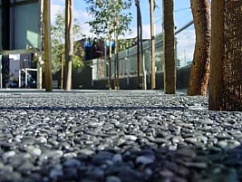 Pebbles:
Pebbles:
Pebbles are also used for sidewalks in a garden. These not only make your garden look attractive but are an eco-friendly option of flooring. Pebbles do not require cement or concrete to fix into place. These can be just put out on the walkway and the work is done. The use of pebbles helps the surface water to drain down into the ground easily.
You can find variety of options for pebbles here »
7. 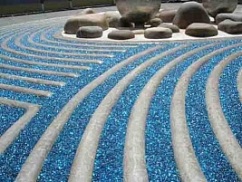 Glass:
Glass:
Lately the use of crushed glass is gaining popularity. These pieces of glass are recycled and environmentally safe.
The glass pieces are smooth without edges and feel like tiny pebbles. These are available in many colors.
Range for crushed glass stones »
So create your own wonderful walkway for the garden and backyard. Select the best suited option for your home from the list here on ProjectLink »
Source: https://www.projectlink.com.au/blog/top-walkway-pavement-ideas/
